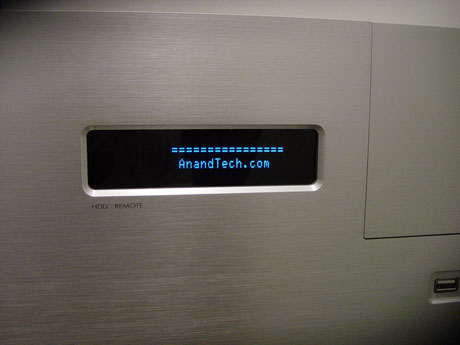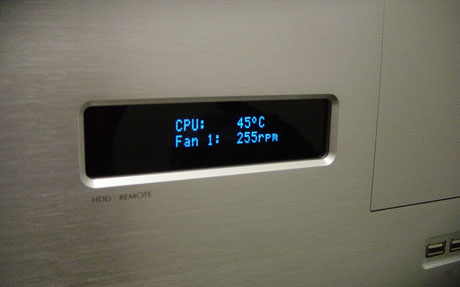A First Look at the HTPC Case Genre with the Ahanix D.Vine 4
by Purav Sanghani on October 10, 2004 1:00 PM EST- Posted in
- Cases/Cooling/PSUs
Extra Features
Many manufacturers will add uneccessary features that take away from the home theater experience more than add to it. As we mentioned before, we should try to stay away from excessive modding such as lighting to help keep the HTPC low key in our home theater setup.One feature that Ahanix has done an extremely good job with in their design is their Vacuum Florescent Display (VFD). Since the D.Vine 3, they have included this 2 line x 16 character display to help the media center experience. With Ahanix's downloadable software, the VFD can be programmed to display various pieces of information such as component temperatures (using MBM 5.1) as well as ID3 tags from Winamp, and even an email notification. This full-featured display offers much more than any other product on the market, which sets it apart from the rest.
Another feature that Ahanix has managed to implement, and others should follow suit, is the IrDA transceiver. No HTPC is complete without the ability to control the system remotely, especially if media center software is to be installed.
As we continue our search for the best HTPC cases, we will look at each product's features to find the most significant features that make each case stand out.












21 Comments
View All Comments
rafaelaustin - Friday, October 29, 2004 - link
Heat and noise are the enemies of an HTPC. The temperatures displayed in this test seem exceptionally low for what I've seen reported by others, usually around 55c. Try this with an Intel CPU or a "slimline" case and see what happens. The 520W Powerstream is overkill. Also, where is the TV tuner? It needs a Hauppauge PVR-250 to make this a real HTPC.rafaelaustin - Friday, October 29, 2004 - link
geogecko - Wednesday, October 20, 2004 - link
When can we expect to see a more comprehensive review of HTPC cases?Some interesting units out there on the net that would be good choices for review, IMO:
http://www.atechfabrication.com/
http://www.ahanix.com/ (other newer options)
http://www.silverstonetek.com/
And especially the new HT-400 from:
http://www.kanam.co.kr/
Bochista - Wednesday, October 13, 2004 - link
My recent purchase of an HDTV puts me in a position where an HTPC would be useful, but I don't think some of the things I intend to do are considered in this review. Some things were hit on however, and I hope to see more cases with these features.1. I need LOTS of storage. Archives of my HD Tivo will take up quite a bit of room.
2. I want to play games on my 62 inch TV, so I need thermals for serious video cards as well.
3. The IR reciever for remote is nice.
4. The ability to have an LED panel acknowledge commands from the remote, display track/time of a movie etc. Also, the ability to dim during movie watching so as to be less of a distraction.
5. Silent Cooling.
pshrink - Wednesday, October 13, 2004 - link
"Another feature that Ahanix has managed to implement, and others should follow suit, is the IrDA transceiver"I can't see anything like a IrDA transceiver in the pictures, and I can't find any info on Ahanix's web site with regard to built-in IrDA capability. Someone please clarify.
tagaste - Wednesday, October 13, 2004 - link
Amen. Why make it seem like the temperatures are a problem when they aren't? They aren't even close. Perhaps the review has to appear 'balanced' but surely perfectly normal operating temperatures shouldn't be given anything like the same weight as ease of access, noise levels, and aesthetic considerations. When normally-clocked HTPCs actually start failing because of heat from poor ventilation or Johnny burns his hand on the case, then it's time to talk about "thermal issues."iwilson - Tuesday, October 12, 2004 - link
The thermal testing is nonsense. An HTPC places noise control a lot higher in importance than thermal load. The temps quoted are nowhere near the level of causing a problem with any of the components. My HTPC has run for several years with less fans than in the article with absolutely no problems. As long as the PC is stable I couldn't care less if the temperature was 500 degrees inside.Case I use is here btw http://www.kanam.co.kr/html/htpc.htm
Bookie - Monday, October 11, 2004 - link
I'm glad you guys are spending more time with the htpc market. I'd like to see a review of silverstone's htpc case. I'm getting ready to drop a lot of money on a new entertainment system (plasma, htpc, and the works), and just want to make the right decision. I'm very interested in the lc02 (black: http://www.silverstonetek.com/products-lc02.htm) with a matx setup, but all the reviews I've read try to fit a full sized mb with all the xtras (unecessary if you ask me). I think that something like this with a mobile processor (mobile athlon 35watt probably) would be the best setup.CrabbyGuy - Monday, October 11, 2004 - link
I think that AnandTech's thermal tests very much need expansion for HTPC cases. Very few people will build a PC in a case like this and then leave it freestanding. Rather, HTPCs will be stacked on (or even under) other home theater components and are likely to be installed in cabinets closed at the rear without fans in many living rooms. Testing the cases' thermals in these situations would be very helpful to many of us. Also, recommendations such as, "Put a fan pulling at least 25CFM behind the right-hand side of the case when installing in a closed cabinet and do not operate an HTPC installed in this case without its being open at the front," would seem especially useful. The alternative is either trial and error or component failure for many users.CrabbyGuy - Monday, October 11, 2004 - link